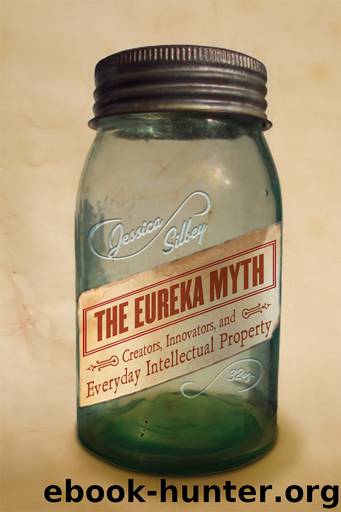The Eureka Myth by Silbey Jessica

Author:Silbey, Jessica [Silbey, Jessica]
Language: eng
Format: epub
Publisher: Stanford University Press
Published: 2014-12-24T16:00:00+00:00
CHAPTER 5
Instruction
How Lawyers Harvest Intellectual Property
IT SHOULD BE CLEAR from my interviews that intellectual property is a legal construct: it exists only after creative and innovative work has begun. Why, then, is IP compared to nature and natural processes so often? For example, in-house IP lawyers frequently describe their role to me as “harvesting IP,” “planting ideas,” and “creating and fitting into an IP landscape.” But IP is not naturally occurring. If anything arises “naturally,” it is the creative flow or the innovative instinct. IP is what happens when an originator lays claim to creative or innovative work through law or when a lawyer fits creative or innovative work into a legal form.
This chapter centers on the role of lawyers and business agents in the making and claiming of IP. How does IP get made and “harvested,” by whom, and under what circumstances? Of course, creative and innovative work happens without lawyers and business agents creating opportunities or incentives through legal means. As the previous chapters detail, creativity and innovation is practiced and is often profitable without IP or with less exclusivity that IP rights provide. But these interviews also contain illustrations of legal intervention via lawyers or business agents to develop IP at a decisive stage of the creative and innovative work.
It becomes clear from analyzing the behavior of lawyers and business agents (and the descriptions of their behavior) that the external force of law—its formal, classical practice of rules and exceptions—shapes creative and innovative work into something recognizable to the business world. Lawyers and business agents, working within the conventional framework of property rights to maximize investments of time and money, appear on the scene and (1) disrupt work, (2) instruct on the law, and (3) thereafter justify their intervention by appealing to economic interests, among others. These types of behavior are not mutually exclusive but a “repertoire of responses to different situations.”1 Indeed, the lawyer or business agent might execute all these functions at different times depending on the circumstances, which reflects the flexibility of law (and lawyers) to adapt to the task at hand.
How does the lawyer or business agent become involved in creative and innovative work? After Chapters 3 and 4, in which the interviewees demonstrate how they often make a living or build a business without strong IP rights (and care a tremendous amount about things like professional reputation that are only weakly protected by IP law), it is easy to forget how important and necessary IP can be. Legal categories or claims (e.g., IP rights) are, of course, more likely to arise when lawyers are involved in creative and innovative activity than when they are not. But the lawyers I spoke with also remind us of the positive role IP can have. Creating IP always happens after the creative and innovative work is in progress or has been completed. In lawyers’ terms, IP demarcates the boundaries of the work that facilitates a foreseeable and hopefully profitable transactions. But that is not all.
Lawyers and
Download
This site does not store any files on its server. We only index and link to content provided by other sites. Please contact the content providers to delete copyright contents if any and email us, we'll remove relevant links or contents immediately.
You Don't Own Me by Orly Lobel(1362)
Intellectual Property Strategy by John Palfrey(1317)
Hello, My Name is Awesome by Alexandra Watkins(1286)
Without Copyrights by Spoo Robert(1182)
Profit From Your Idea: How to Make Smart Licensing Deals by Attorney Richard Stim(1161)
Democracy of Sound by Alex Sayf Cummings(1147)
A Triumph of Genius: Edwin Land, Polaroid, and the Kodak Patent War by Ronald K. Fierstein(1117)
The Trademark Guide by Lee Wilson(1116)
World War 3.0 by Ken Auletta(1082)
The Copywriter's Handbook by Robert W. Bly(1075)
Data Protection: A Practical Guide to UK and EU Law by Carey Peter(1066)
Kafka's Last Trial by Benjamin Balint(1060)
BVR's Guide to Intellectual Property Valuation by Michael Pellegrino(1011)
Mass Media Law by Pember Don & Pember Don(997)
Patent It Yourself: Your Step-by-Step Guide to Filing at the U.S. Patent Office by Pressman David Attorney(994)
Hello, My Name Is Awesome: How to Create Brand Names That Stick (BK Business) by Alexandra Watkins(989)
What They'll Never Tell You About the Music Business by Peter M. Thall(989)
The Tech Contracts Handbook: Software Licenses and Technology Services Agreements for Lawyers and Businesspeople by David Tollen(981)
The New Censorship: Inside the Global Battle for Media Freedom by Joel Simon(950)
